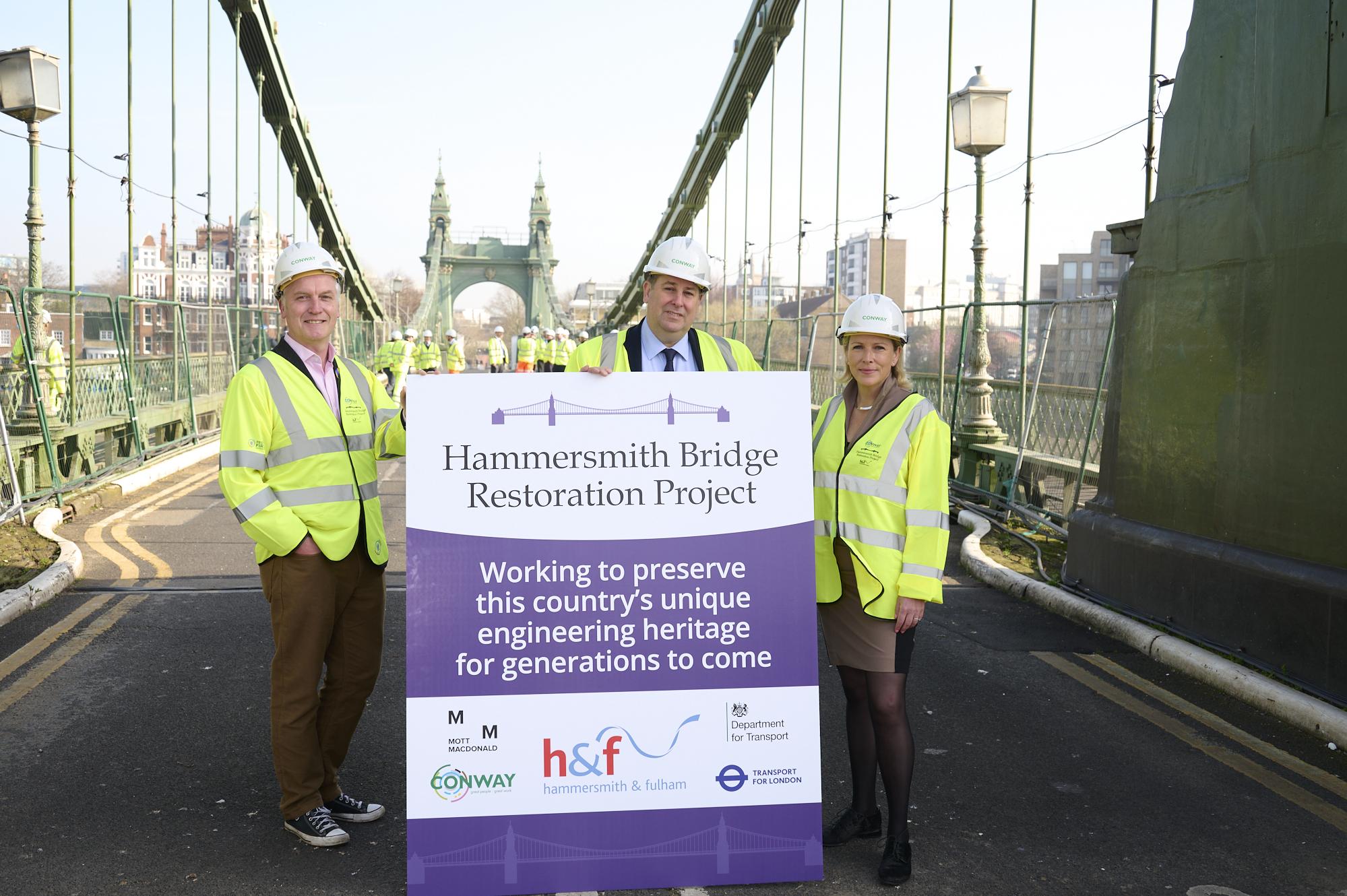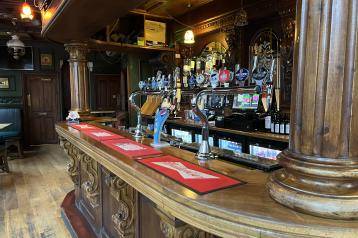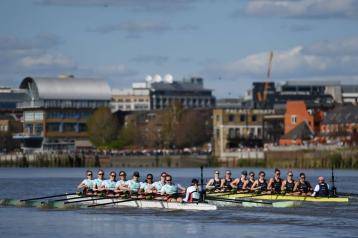
Pictured left to right are Cllr Gareth Roberts, Leader of Richmond Council, Cllr Stephen Cowan, Leader of H&F Council, and Baroness Vere, Parliamentary Under-Secretary of State in the Department for Transport, officially marking the beginning of the Hammersmith Bridge Restoration Project
The Hammersmith Bridge Restoration Project was officially launched today (22 March 2022) by Hammersmith & Fulham Leader Cllr Stephen Cowan, representatives from Transport for London (TfL), Baroness Vere, Parliamentary Under-Secretary of State at the Department for Transport (DfT), and Cllr Gareth Roberts, Leader of Richmond Council.
The visit came on the day the government confirmed that it will pay its one-third share of the Phase 1 £8.9million stabilisation works. TfL is also expected to confirm its contribution.
The stabilisation works are necessary to prevent future closures of the 135-year-old Grade II* listed structure to pedestrians, cyclists and river traffic below, and to secure the bridge to enable its subsequent full strengthening and restoration.
The works - which began last month - were expedited after Hammersmith & Fulham Council decided in December to approve the £8.9m investment in full, in anticipation of the DfT and TfL subsequently agreeing to pay their shares.

H&F forges ahead
Cllr Cowan said: "I am determined to fix the bridge as speedily as possible. That's why we took the initiative to begin the stabilisation works and to kickstart the full restoration project.
"So, I am very pleased that Baroness Vere has joined us today and formally announced the Department for Transport's commitment to help fund the restoration project. We welcome that contribution. We look forward to TfL following suit.
"Hammersmith Bridge is one of the world's oldest suspension bridges, a unique part of our country's engineering heritage and one of the most expensive bridges in Britain to repair.
"Thanks to the award-winning work by the H&F team of world-leading engineers, we have been able to re-open the bridge to pedestrians, cyclists and river traffic below.
"Now we're forging ahead with the £8.9m stabilisation programme after our team developed an alternative solution which will save local and national taxpayers £21m compared to the previous proposal."
While Cllr Roberts said: "Today is good news for residents on both sides of the bridge. It is reassuring to see H&F engineers getting on with the job and committing to keeping the bridge open as much as possible during the works programme. I also warmly welcome Baroness Vere's confirmation that the Department for Transport will pay its one-third share."

Repairing one of the world's oldest suspension bridges
Cllr Cowan, Baroness Vere, Cllr Roberts and TfL's David Rowe, Head of Major Projects & Renewals, as well as Alex Batey, TfL's Director of Investment Delivery Planning, were given a behind-the-scenes look at the work currently taking place to repair cracks in the cast-iron pedestals which are believed to have been caused by unchecked corrosion dating back over 70 years to when the bridge was owned by London County Council.
H&F Council's specialist contractors will be removing all the casings of the four corner cast-iron pedestals. This work is being undertaken by our contractor FM Conway and their sub-contractors, Freyssinet Ltd and Taziker Industrial Ltd. Arcadis have been appointed as project manager.
Once the four casings have been removed, the contractor is required to fill the pedestals with concrete, install steel frames around them and jack up elements of the structure to replace the bearings.
The casing removals and jacking operations will be undertaken using cranes that will be positioned on the carriageway at both entrances to the bridge.
The Phase 1 stabilisation work is expected to be completed by the end of October.
The Phase 2 strengthening and full restoration works, which will allow the bridge to re-open to buses and cars, will take place following completion of the stabilisation project.
Moving towards full re-opening
On 7 March, we allocated a further £3.5m investment to start the essential expert studies which will lead to the Phase 2 full strengthening and restoration programme.
That includes essential concept design work on the alternative proposal developed by architects and engineers Foster + Partners and specialist bridge engineers COWI.
This project, which is being considered alongside the existing TfL plan, could see a temporary double-decker crossing installed using the existing bridge foundations. It may see the bridge opening to motor vehicles and buses two years earlier than proposed previously and at a lower cost to taxpayers.
Other necessary work being carried out involves geotechnical studies, crowd-loading assessments and traffic modelling. H&F is once again providing the funding upfront, to expedite the full re-opening of the bridge.
New rules to keep bridge safe
To enable the works to be undertaken safely, the main carriageway section of the bridge is now closed off.
The bridge continues to be open to pedestrians. Cyclists, motorcylists and legal e-scooters can also still cross the bridge provided they dismount and share the footways with pedestrians. The towpath on the Barnes side of the bridge will remain open.
Access over the bridge will only be interrupted for safety reasons when jacking operations are in progress. This will only be undertaken for short periods and advance notification will be given to residents and users.
Want to read more news stories like this? Subscribe to our weekly e-news bulletin.




